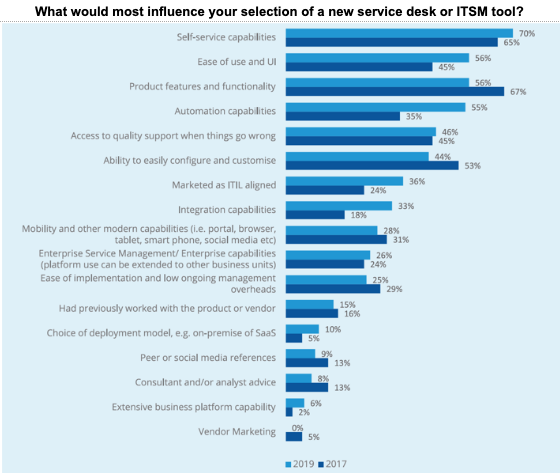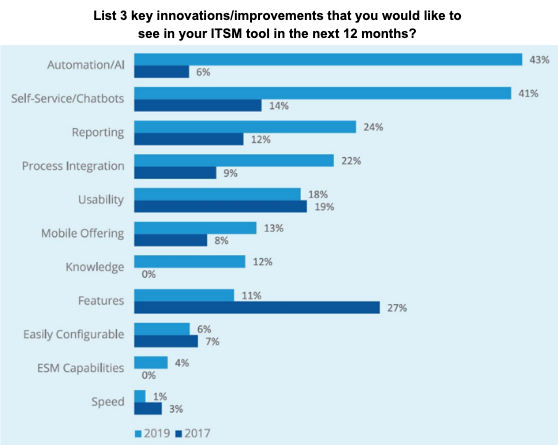
Increased ITSM Automation and Better Self-Service? Yes Please!
During these difficult times, we need to appreciate all the people involved in IT support and how they’re often keeping employees and the organization as a whole afloat in these new working conditions. I vote that we have a SysAdmin Appreciation Week, rather than a SysAdmin Appreciation Day, this July.
Not only is it important to appreciate our IT support personnel and their efforts during the COVID-19 crisis, but we also need to ensure that they’re suitably enabled to do their work. This includes the technology they have at their disposal – for example, the corporate IT service desk or IT service management (ITSM) tool. Especially in terms of how well that tool is enabling their IT service and support needs in light of meeting increased employee expectations.
What IT support teams want and need from their IT service desk or ITSM tool
At SysAid, we like to think that not only do we listen to, and act upon, the needs of our customers but also that we’re up on industry trends such as those highlighted in the latest Service Desk Institute (SDI) report – “A View from the Frontline 2019.” It’s a regular SDI report that – to quote SDI – “takes a snapshot of the industry and looks at what services desks benefit from and struggle with in terms of their ITSM tools, their vendors, and their innovation.” It’s a great industry bellwether for both IT support pros and the many companies that provide them with ITSM tools and services.
With the latest report, as a provider of an IT support tool, it’s great for us to see that our improvements and investments are well-aimed at what the members of the IT support industry are crying out for.
What do IT help desks and IT service desks really need from ITSM tools?
Much has been written and said about the complexity of ITSM tool selection – with the need to balance various business requirements, current and future needs, plus of course the associated costs. And now there’s also additional enterprise service management needs to fold into the mix and the priorities of other business stakeholders from lines of business such as human resources (HR), facilities, and procurement.
This blog takes a deep dive into a report by @SDI_Institute looking at the key influences on modern #ITSM tool selection. Click To TweetTo help, the new SDI report looks at the key influences on modern ITSM tool selection, with these shown in the chart below.

Source: SDI, “A View from the Frontline 2019”
Of course, there’s a need for the core ITSM capabilities – or otherwise, it wouldn’t cut the mustard as an ITSM tool. But, despite this, the chart shows that self-service capabilities have become the leading influence on the selection of an ITSM tool, having been identified by 70% of respondents as key (an increase of 5% since 2017).
And now during the COVID-19 crisis, self-service, along with remote support capabilities, are needed more than ever by both the likely-overworked IT support team and the now-remote employees that they’re supporting.
However, while self-service offers many great improvement opportunities to IT service desks, there have been many barriers to its successful adoption (by employees). With improvements needed in a variety of areas to help your, or any other, organization to successfully deliver their new IT self-service capabilities.
What’s needed for higher levels of employee adoption (of IT self-service)?
To start, there needs to be fit-for-purpose technology. But let’s park this for a moment – because it isn’t enough, because even great self-service technology will likely struggle without what follows.
First, there needs to be the right approach or motivation for self-service. A focus on cost reduction rarely works. Instead, the objective of self-service needs to be of value to the people you want to use it – your organization’s employees (with cost reduction a welcome byproduct of the self-service capability’s use). It’s the “What’s in it for me?” that will likely relate to speedier and anytime access to assistance, and a better employee experience that’s increasingly being influenced, expectations-wise, by employees’ personal-life, consumer-world experiences. With this a vital building block that underpins everything else.
Ultimately, employees who might be struggling to adjust to home working, while potentially having a higher level of work to do during the COVID-19 firefighting, needs a self-service capability that works for them not just the IT department.
So, second, the self-service capability needs to be built around your employees, not a technology-created view of self-service. Not only is this related to the employee experience, but self-service also needs to be aligned with ways of working. Importantly, aligned with how employees want and do work, rather than the corporate expectation of how employees should work.
The bottom line here is that if it’s harder, more inconvenient, or less fruitful to use self-service, then employees will continue to use the traditional telephone and email channels. It’s something that too-often negates the anticipated benefits of self-service and the promised return on investment (ROI).
Third, organizational change management tools and techniques are vital in what’s essentially a people-related change. You can read more about what this involves in my What’s Organizational Change Management and Why Should ITSM Pros Be Bothered? blog.
Then, finally, back to the need for fit-for-purpose self-service technology. It needs to be able to help deliver against the above. From providing that better employee experience, through being flexible enough to align with preferred ways of working, to being as good as the best consumer-world self-service capabilities. It’s why SysAid has significantly invested in our solution’s self-service capabilities and will continue to do so as employee wants and needs evolve over time.
Did you also spot the big jump for automation?
To quote the SDI report:
“Automation capabilities have also increased significantly in its influence on tool selection. Similar to self-service, automation can have many benefits for the service desk, from workload reduction, streamlined processes, and increased speed and efficiency of IT services. 2017 actually saw a reduction in the proportion of respondents highlighting that automation capabilities are a key influence, dropping from 62% to 35%, yet this year we can see that this proportion has increased by 20%.”
So, the big jump is actually a rebound – with this likely due to the growing interest in artificial intelligence (AI)-enabled IT support capabilities. Or, as it’s often called – AI and automation. This is reflected in another of the report’s charts related to desired innovations/improvements:

Source: SDI, “A View from the Frontline 2019”
For SysAid, the top-three sought after innovations/improvements to IT service desks are a direct map onto where we’ve been investing in our solution (to better meet customers’ current and future needs). We started with our reporting and analytics (which includes business intelligence (BI) and benchmarking capabilities). Then we commenced the introduction of a portfolio of AI and automation capabilities that includes service orchestration. And finally, we’re upgrading our self-service capability that we’re calling consumer-grade, rather than enterprise-grade, self-service. With an even better employee experience that will help to drive up employee adoption and use (and consequently the ROI).
Although, I shouldn’t have just said “finally.” Because we’re constantly trying to improve the capabilities we offer our customers. For example, there’s the new SysAid Workflow Designer – which allows process managers to easily (and quickly) create or change, share, and optimize digital processes. It’s a capability that our customers have found invaluable as they change their traditional processes and workflows to reflect COVID-19-affected operations, including the addition of more automation.
I hope you found these SDI stats useful. If you want to share any automation or self-service advice or opinions with others, then please leave a comment. Thank you.







